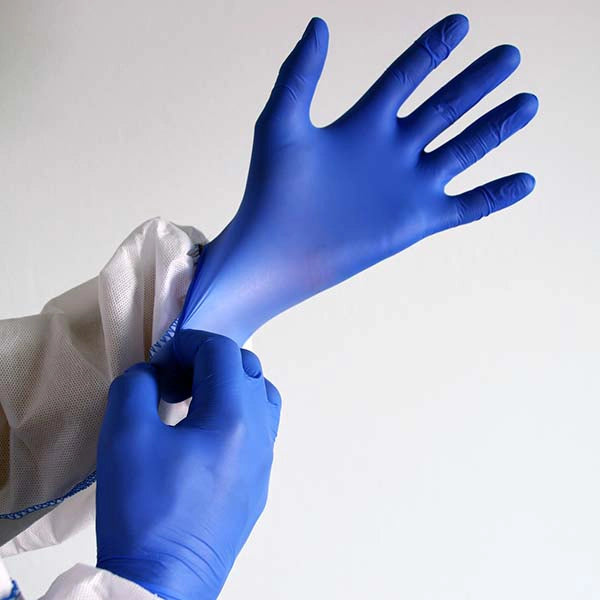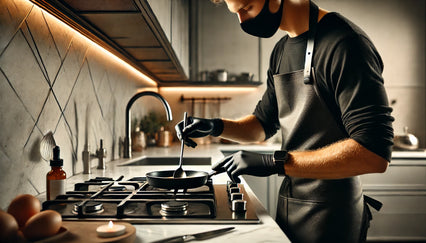Cut resistant gloves are a must-have accessory in any kitchen, whether you're a professional chef or a home cook. They provide a protective barrier between your hands and sharp knives, graters, and mandolines, reducing the risk of cuts and injuries.
In this article, we'll explore what cut resistant gloves are, their benefits, and how to choose the right pair for your needs.
What are Cut Resistant Gloves for Cooking?
Cut resistant gloves are specialized hand protection designed to prevent cuts and lacerations while handling sharp objects in the kitchen. These gloves are typically made from high-strength materials like Kevlar, Dyneema, or high-performance polyethylene (HPPE) fibers that are tightly woven together to create a protective barrier.
The level of cut resistance varies among different gloves, with higher levels offering greater protection against sharp edges. Cut resistance is measured using standards like the ANSI/ISEA 105-2016 in the United States or the EN 388 in Europe, which assign ratings based on the glove's ability to withstand cuts from a sharp blade.
Types of Cut Resistant Gloves for Cooking
When choosing the best cut resistant gloves for your cooking needs, you'll come across various types designed for different purposes. Understanding the differences between these gloves will help you make an informed decision and select the pair that best suits your requirements.
Lightweight and Flexible Gloves
Lightweight and flexible cut resistant gloves are perfect for precise tasks and handling small objects in the kitchen. These gloves are typically made from thinner, more pliable materials that allow for greater dexterity and control. They are ideal for tasks like slicing vegetables, grating cheese, or peeling fruits, where you need to maintain a good grip and feel for the food you're working with.
These gloves often feature a snug fit and a textured surface to enhance grip, preventing slips and accidents. While they may not offer the same level of protection as heavy-duty gloves, lightweight and flexible gloves strike a balance between safety and maneuverability, making them a popular choice for everyday kitchen tasks.
Heavy-Duty Cut Resistant Gloves
For more demanding kitchen tasks, heavy-duty cut resistant gloves provide an extra layer of protection. These gloves are thicker and more robust, often made from materials like Kevlar, stainless steel fibers, or a combination of high-strength fabrics. They are designed to withstand sharp blades and rough edges, making them suitable for tasks like butchering meat, shucking oysters, or handling large, sharp knives.
Heavy-duty gloves may sacrifice some dexterity for increased protection, but they are still comfortable enough to wear for extended periods. They are a must-have for professional chefs and home cooks who frequently work with sharp tools and require maximum hand protection.
Ambidextrous Cut Resistant Gloves
Ambidextrous cut resistant gloves are designed to fit either hand, providing added convenience and flexibility. These gloves eliminate the need to worry about left or right-handed specific gloves, making them easy to share among multiple users or quickly switch between hands during use.
Ambidextrous gloves are particularly useful in fast-paced kitchen environments where time is of the essence. They allow you to quickly put on a glove without having to search for the correct hand, reducing the risk of cross-contamination and increasing efficiency.
When selecting ambidextrous cut resistant gloves, ensure that they still provide a snug and comfortable fit to maintain proper grip and dexterity. Some gloves may feature a reversible design or a more generalized shape to accommodate both hands.
5 Best Cut Resistant Gloves for Cooking
1. HyFlex® 11-751 Cut-Resistant Gloves
These gloves are crafted with a polyurethane palm coating and a seamless knit liner, offering an ANSI Cut Level A3 protection. They are designed for tasks requiring both precision and protection, providing a balance between cut resistance and dexterity.
Shop HyFlex 11-751 Cut-Resistant Gloves and save up to 50% now
Use Cases:
- Kitchen Use: Perfect for slicing, dicing, and other precision cutting tasks where protection from sharp blades is crucial.
- Industrial Use: Ideal for light assembly work, small parts handling, and tasks that require a combination of safety and fine motor skills.
Industries:
- Food Processing
- Automotive
- Metal Fabrication
- General Manufacturing.
2. HyFlex® 11-735 Polyurethane Palm Coated Gloves
Featuring high-strength fibers and a polyurethane coating, these gloves offer ANSI Cut Level A4 protection. They provide excellent grip and are designed for durability in high-risk environments where cut protection is essential.
Shop HyFlex 11-735 Polyurethane Palm Coated Gloves and save up to 50% now
Use Cases:
- Kitchen Use: Suitable for handling sharp kitchen tools such as mandolines and graters, especially in professional kitchens.
- Industrial Use: Widely used in glass handling, construction, and metal fabrication where the risk of cuts is high.
Industries:
- Food Service
- Construction
- Glass Handling
- Metal Fabrication.
3. HyFlex® 11-518 Polyurethane Palm Coated Gloves
Made from a blend of Dyneema® and Spandex, these gloves offer lightweight yet high cut resistance (ANSI Cut Level A3). They are designed for applications where both touch sensitivity and protection are necessary.
Use Cases:
- Kitchen Use: Ideal for delicate tasks such as filleting fish or deboning meat, where precision and protection are key.
- Industrial Use: Used in electronics manufacturing, precision assembly, and other tasks requiring a high degree of dexterity.
Industries:
- Food Processing
- Precision Assembly
- Electronics Manufacturing
- Light Construction.
4. Ansell VersaTouch® Canners Gloves
These latex gloves feature a fishscale texture for enhanced grip, making them ideal for wet or slippery conditions. They are designed specifically for food handling, providing a secure grip and moderate cut protection.
Use Cases:
- Kitchen Use: Excellent for food preparation tasks such as canning, slicing, and handling slippery items like fish or poultry.
- Industrial Use: Used in food processing plants, especially where workers handle wet or oily products.
Industries:
- Food Processing
- Food Service
- Hospitality
- Agriculture.
5. HyFlex® 11-541 Nitrile Foam Palm Coated Gloves
These gloves are made with a Kevlar® liner and nitrile foam coating, offering very high cut resistance (ANSI Cut Level A5). They are designed for heavy-duty tasks where maximum protection and grip are required.
Shop HyFlex 11-541 Nitrile Foam Palm Coated Gloves and save up to 50% now
Use Cases:
- Kitchen Use: Ideal for heavy-duty kitchen tasks such as butchering, shucking oysters, and handling large, sharp tools.
- Industrial Use: Suitable for use in environments such as metal fabrication, heavy-duty construction, and glass handling where extreme cut protection is needed.
Industries:
- Food Processing
- Butchery
- Heavy-Duty Construction
- Metal Fabrication.
Benefits of Using Cut Resistant Gloves for Cooking
Enhanced Safety
Cut resistant gloves provide a protective barrier between your hands and sharp kitchen tools, significantly reducing the risk of cuts, lacerations, and punctures. Whether you're slicing vegetables with a mandoline, grating cheese, or handling sharp knives, these gloves offer peace of mind and help prevent painful injuries that could sideline you from cooking.
Improved Grip and Dexterity
Many cut resistant gloves feature textured surfaces or coatings that enhance your grip on slippery objects. This improved grip is particularly useful when working with wet or oily foods, as it helps prevent accidental slips that could lead to injuries. Additionally, well-designed cut resistant gloves allow for excellent dexterity, enabling you to perform precise tasks with ease.
Versatility
Cut resistant gloves are versatile tools that can be used for a wide range of kitchen tasks. From slicing and dicing vegetables to handling sharp meat bones or shucking oysters, these gloves provide protection and flexibility. Their versatility makes them a valuable addition to any kitchen, whether you're a professional chef or a home cook.
Food Safety Compliance
When choosing cut resistant gloves for cooking, look for options made from food-safe materials that won't contaminate your ingredients. Many gloves are constructed from materials that are FDA compliant and safe for direct food contact. By using food-safe cut resistant gloves, you not only protect your hands but also ensure that your food remains uncompromised.
How Do Cut Resistant Gloves Work?
Cut resistant gloves are engineered to protect your hands from sharp edges and potential injuries while handling knives, graters, and other kitchen tools. These gloves are made from high-strength materials that are tightly woven or knitted together to create a protective barrier between your skin and the sharp object.
The most common materials used in cut resistant gloves include:
- High-performance polyethylene (HPPE): This lightweight, high-strength synthetic fiber is known for its excellent cut resistance and durability.
- Kevlar: Developed by DuPont, Kevlar is a para-aramid fiber that offers exceptional strength and heat resistance. It is often used in bulletproof vests and other protective gear.
- Dyneema: Similar to HPPE, Dyneema is an ultra-high molecular weight polyethylene (UHMWPE) fiber that provides superior cut resistance and strength-to-weight ratio.
- Stainless steel: Some cut resistant gloves incorporate stainless steel fibers or mesh to enhance their protective properties and durability.
These materials are carefully selected and combined to create gloves that can withstand sharp edges and prevent cuts. The tightness of the weave or knit, along with the inherent strength of the fibers, determines the level of cut resistance the gloves provide.
Cut resistance levels are measured using standardized tests, such as the ANSI/ISEA 105-2016 in the United States or the EN 388 in Europe. These tests involve applying a specific amount of force and pressure with a sharp blade to determine how well the glove material resists cuts. The resulting scores are then categorized into different levels, with higher levels indicating greater cut protection.
For example, the ANSI/ISEA 105-2016 standard ranks cut resistance on a scale from A1 to A9, with A1 being the lowest level of protection and A9 the highest. When choosing cut resistant gloves for cooking, consider the level of protection you need based on the tasks you'll be performing and the tools you'll be using.
It's important to note that while cut resistant gloves provide a significant level of protection, they are not completely cut-proof. Proper care and attention should still be exercised when handling sharp objects, and the gloves should be replaced if they show signs of wear or damage.
How to Choose the Best Cut Resistant Gloves for Your Kitchen
When selecting the best cut resistant gloves for your cooking needs, there are several key factors to consider. Taking the time to evaluate these aspects will help you find the perfect pair of gloves that offer the right balance of protection, comfort, and functionality.
Consider the Level of Cut Resistance Required
Different kitchen tasks pose varying levels of risk, so it's important to assess the types of activities you'll be performing and the level of protection you need. If you frequently work with extremely sharp knives or engage in tasks like butchering meat or shucking oysters, opt for gloves with a higher cut resistance rating, such as ANSI level A5 or above. For general kitchen duties like slicing vegetables or grating cheese, gloves with a lower rating, such as ANSI level A2 or A3, may suffice.
Look for Comfort and Flexibility
While protection is paramount, it's also crucial to choose gloves that allow for easy movement and dexterity. Look for gloves made from lightweight, flexible materials that enable you to maintain a good grip on your tools and ingredients. Gloves with a snug fit and a textured surface can enhance your grip, preventing slips and accidents. Consider the thickness of the gloves as well, as thicker gloves may offer more protection but can limit your dexterity and touch sensitivity.
Ensure Proper Fit
Ill-fitting gloves can be a safety hazard in the kitchen, as they may cause slippage or get caught on sharp edges. When selecting cut resistant gloves, ensure that they fit snugly on your hands without being too tight or restrictive. Measure your hand size according to the manufacturer's guidelines and refer to their size chart to find the best fit. Some gloves are available in multiple sizes, while others feature a stretchable material that adapts to different hand shapes.
Opt for Food-Safe Materials
As you'll be handling food while wearing your cut resistant gloves, it's essential to choose gloves made from materials that comply with food safety regulations. Look for gloves that are FDA compliant and safe for direct food contact. Many cut resistant gloves are made from food-grade materials like high-performance polyethylene (HPPE), Kevlar, or Dyneema, which are non-toxic and won't contaminate your ingredients. Avoid gloves with coatings or treatments that may not be food-safe, and always check the manufacturer's specifications to ensure compliance with food safety standards.
5 Tips for Using Cut Resistant Gloves Effectively in the Kitchen
Always Wear Gloves When Handling Sharp Objects
Make it a habit to don your cut resistant gloves whenever you work with sharp knives, mandolines, graters, or other potentially dangerous kitchen tools. Consistency is key to preventing accidents and protecting your hands from cuts and lacerations.
Replace Gloves Regularly
Over time, even the most durable cut resistant gloves can experience wear and tear. Inspect your gloves frequently for signs of damage, such as fraying, thinning, or small cuts. If you notice any deterioration, replace the gloves promptly to ensure they continue to provide optimal protection.
Use the Right Glove for the Task
Different kitchen tasks require varying levels of cut resistance and glove features. For example, when handling delicate tasks like slicing soft fruits or grating cheese, you may prefer lightweight, flexible gloves that allow for greater dexterity. On the other hand, when working with heavy-duty tasks like butchering meat or shucking oysters, thicker, more robust gloves with a higher cut resistance rating are a better choice. Select the appropriate glove for each task to maximize both safety and efficiency.
Clean and Store Gloves Properly
Proper care and maintenance of your cut resistant gloves are essential for their longevity and effectiveness. After each use, clean your gloves according to the manufacturer's instructions. Some gloves may be machine washable, while others require hand washing. Allow the gloves to air dry completely before storing them in a clean, dry place away from direct sunlight or extreme temperatures. Proper cleaning and storage help maintain the gloves' protective properties and prevent the growth of bacteria.
Use Cut Resistant Gloves in Combination with Safe Knife Techniques
While cut resistant gloves provide an important layer of protection, they should not be relied upon as the sole means of preventing injuries. Practicing proper knife skills and techniques is equally important. Always keep your knives sharp, as dull blades require more force and are more likely to slip.
Use a cutting board and keep your fingers tucked away from the blade. Maintain a stable grip on the knife handle, and avoid distractions while cutting. By combining the use of cut resistant gloves with safe knife handling practices, you significantly reduce the risk of accidents and injuries in the kitchen.
Where to Buy the Best Resistant Gloves for Cooking
Choosing the best cut resistant gloves for cooking ensures safety, comfort, and efficiency in the kitchen. Gloves.com offers a wide range of high-quality gloves that cater to various needs and provide top-notch protection.
Shop the Best Cut Resistant Gloves for Cooking and save up to 50%





